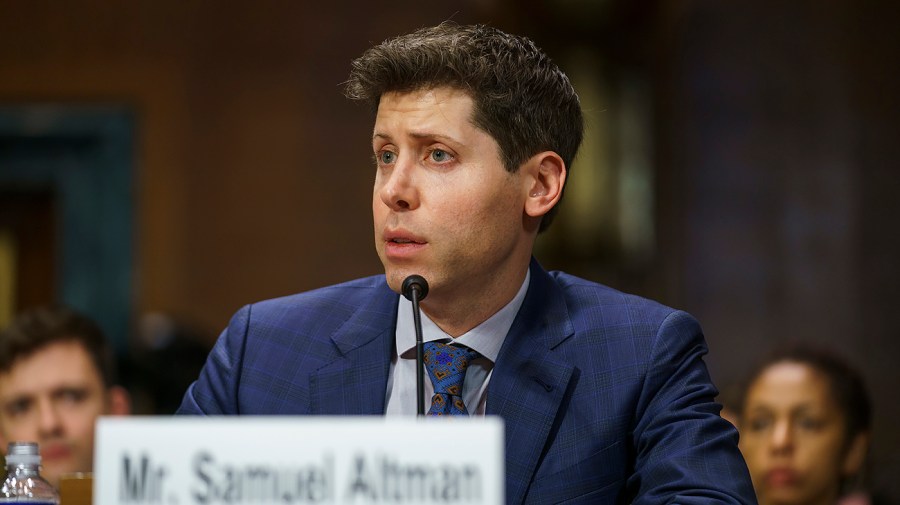Business
OpenAI-Sam Altman saga: What we know so far on November 21, 2023 at 10:34 pm Business News | The Hill

The surprise ouster of OpenAI co-founder and former CEO Sam Altman has triggered widespread fallout at the artificial intelligence (AI) company behind the popular ChatGPT tool.
Here’s what we know so far about the company’s messy split with Altman:
OpenAI announces Sam Altman stepping down as CEO on Nov 17
The company made the surprise leadership change Friday afternoon, announcing that Altman would be stepping down as CEO after a review found that he was “not consistently candid in his communications with the board.”
“OpenAI was deliberately structured to advance our mission: to ensure that artificial general intelligence benefits all humanity,” the board of directors said in statement. “The board remains fully committed to serving this mission.”
“We are grateful for Sam’s many contributions to the founding and growth of OpenAI,” it continued. “At the same time, we believe new leadership is necessary as we move forward.”
Greg Brockman, the president of OpenAI and chair of its board, quit over Altman’s ouster. In a post on X, the platform formerly known as Twitter, Brockman said both he and Altman were “still trying to figure out exactly what happened.”
“Sam and I are shocked and saddened by what the board did today,” Brockman wrote Friday night. “Let us first say thank you to all the incredible people who we have worked with at OpenAI, our customers, our investors, and all of those who have been reaching out.”
Brockman said the former CEO received a message from OpenAI’s chief scientist and board member Ilya Sutskever on Thursday night asking to talk the next day. When he joined the Google Meet on Friday, Altman was reportedly told he was being fired.
Shortly after, Brockman also received a message from Sutskever asking for a quick call, during which he was informed that he was being removed as chair the board.
OpenAI cycles through CEOs amid upheaval
In its initial announcement Friday, OpenAI said that chief technology officer Mira Murati would take over as interim CEO, effective immediately.
The company touted Murati’s “critical role” in the growth of OpenAI from a small startup to an AI leader.
“As the leader of the company’s research, product, and safety functions, Mira is exceptionally qualified to step into the role of interim CEO,” the board said Friday. “We have the utmost confidence in her ability to lead OpenAI during this transition period.”
Murati — who appeared to show her support for Altman online, responding to a Saturday post from her predecessor with a heart emoji — reportedly negotiated with OpenAI’s board over the weekend in an effort to rehire Altman and Brockman, according to Bloomberg.
However, Emmett Shear, the former CEO of Twitch, revealed early Monday morning that he was taking over as interim chief of the AI company.
Shear acknowledged that “the process and communications around Sam’s removal has been handled very badly” and “seriously damaged our trust,” and he announced plans to launch an independent investigation into Altman’s ouster in his first 30 days.
“Depending on the results [of] everything we learn from these, I will drive changes in the organization — up to and including pushing strongly for significant governance changes if necessary,” he said in a post on X.
“OpenAI’s stability and success are too important to allow turmoil to disrupt them like this,” Shear added.
Microsoft scoops up Altman, Brockman
Amid the turmoil, Microsoft Chairman and CEO Satya Nadella announced late Sunday night that Altman and Brockman would be joining Microsoft to lead a new advanced AI research team.
“We look forward to moving quickly to provide them with the resources needed for their success,” Nadella said in a post on X.
“We remain committed to our partnership with OpenAI and have confidence in our product roadmap, our ability to continue to innovate with everything we announced at Microsoft Ignite, and in continuing to support our customers and partners,” he added. “We look forward to getting to know Emmett Shear and [OpenAI’s] new leadership team and working with them.”
Microsoft has reportedly invested $13 billion into OpenAI since 2019.
Hundreds of OpenAI employees threaten to quit
In the wake of Altman’s ouster, more than 700 employees at OpenAI are threatening to quit and follow the former CEO to Microsoft, unless the board resigns and reinstates Altman and Brockman, Wired reported.
“The process through which you terminated Sam Altman and removed Greg Brockman from the board has jeopardized all of this work and undermined our mission and company,” the employees wrote, according to Wired. “Your conduct has made it clear you did not have the competence to oversee OpenAI.”
The letter was signed by Murati, as well as Sutskever, the board member. Sutskever said in a post Monday that he “deeply” regrets his participation in the board’s recent actions and “never intended to harm OpenAI.”
“I love everything we’ve built together and I will do everything I can to reunite the company,” Sutskever said.
Amid the revolt at OpenAI, Microsoft on Tuesday appeared to be prepared to take employees up on their offer to follow Altman to the company.
“To my partners at OpenAI: We have seen your petition and appreciate your desire potentially to join Sam Altman at Microsoft’s new AI Research Lab. Know that if needed, you have a role at Microsoft that matches your compensation and advances our collective mission,” Microsoft’s chief technology officer, Kevin Scott, said in a post on X.
Technology, Business, News, Artificial Intelligence, ChatGPT, Emmett Shear, generative AI, Greg Brockman, Ilya Sutskever, Microsoft, Mira Murati, OpenAI The surprise ouster of OpenAI co-founder and former CEO Sam Altman has triggered widespread fallout at the artificial intelligence (AI) company behind the popular ChatGPT tool. Here’s what we know so far about the company’s messy split with Altman: OpenAI announces Sam Altman stepping down as CEO on Nov 17 The company made the surprise…
Business
Why 9 Million Americans Have Left

The Growing American Exodus
Nearly 9 million Americans now live outside the United States—a number that rivals the population of several states and signals a profound shift in how people view the American dream. This mass migration isn’t confined to retirees or the wealthy. Thanks to remote work, digital nomad visas, and mounting pressures at home, young professionals, families, and business owners are increasingly joining the ranks of expats.

Rising Costs and Shrinking Wallets
Living in the US has become increasingly expensive. Weekly grocery bills topping $300 are not uncommon, and everyday items like coffee and beef have surged in price over the last year. Rent, utilities, and other essentials also continue to climb, leaving many Americans to cut meals or put off purchases just to make ends meet. In contrast, life in countries like Mexico or Costa Rica often costs just 50–60% of what it does in the US—without sacrificing comfort or quality.
Health Care Concerns Drive Migration
America’s health care system is a major trigger for relocation. Despite the fact that the US spends more per person on health care than any other country, millions struggle to access affordable treatment. Over half of Americans admit to delaying medical care due to cost, with households earning below $40,000 seeing this rate jump to 63%. Many expats point to countries such as Spain or Thailand, where health care is both affordable and accessible, as a major draw.

Seeking Safety Abroad
Public safety issues—especially violent crime and gun-related incidents—have made many Americans feel unsafe, even in their own communities. The 2024 Global Peace Index documents a decline in North America’s safety ratings, while families in major cities often prioritize teaching their children to avoid gun violence over simple street safety. In many overseas destinations, newly arrived American families report a significant improvement in their sense of security and peace of mind.
Tax Burdens and Bureaucracy
US tax laws extend abroad, requiring expats to file annual returns and comply with complicated rules through acts such as FATCA. For some, the burden of global tax compliance is so great that thousands relinquish their US citizenship each year simply to escape the paperwork and scrutiny.
The Digital Nomad Revolution
Remote work has unlocked new pathways for Americans. Over a quarter of all paid workdays in the US are now fully remote, and more than 40 countries offer digital nomad visas for foreign professionals. Many Americans are leveraging this opportunity to maintain their US incomes while cutting costs and upgrading their quality of life abroad.

Conclusion: Redefining the Dream
The mass departure of nearly 9 million Americans reveals deep cracks in what was once considered the land of opportunity. Escalating costs, inaccessible healthcare, safety concerns, and relentless bureaucracy have spurred a global search for better options. For millions, the modern American dream is no longer tied to a white-picket fence, but found in newfound freedom beyond America’s borders.
Business
Will Theaters Crush Streaming in Hollywood’s Next Act?

Hollywood is bracing for a pivotal comeback, and for movie lovers, it’s the kind of shake-up that could redefine the very culture of cinema. With the freshly merged Paramount-Skydance shaking up its strategy, CEO David Ellison’s announcement doesn’t just signal a change—it reignites the passion for moviegoing that built the magic of Hollywood in the first place.

Theatrical Experience Roars Back
Fans and insiders alike have felt the itch for more event movies. For years, streaming promised endless options, but fragmented attention left many longing for communal spectacle. Now, with Paramount-Skydance tripling its film output for the big screen, it’s clear: studio leaders believe there’s no substitute for the lights, the hush before the opening credits, and the collective thrill of reacting to Hollywood’s latest blockbusters. Ellison’s pivot away from streaming exclusives taps deep into what unites cinephiles—the lived experience of cinema as art and event, not just content.
Industry Pulse: From Crisis to Renaissance
On the financial front, the numbers are as electrifying as any plot twist. After years of doubt, the box office is roaring. AMC, the world’s largest theater chain, reports a staggering 26% spike in moviegoer attendance and 36% revenue growth in Q2 2025. That kind of momentum hasn’t been seen since the heyday of summer tentpoles—and it’s not just about more tickets sold. AMC’s strategy—premium screens, with IMAX and Dolby Cinema, curated concessions, and branded collectibles—has turned every new release into an event, driving per-customer profits up nearly 50% compared to pre-pandemic norms.
Blockbusters Lead the Culture
Forget the gloom of endless streaming drops; when films like Top Gun: Maverick, Mission: Impossible, Minecraft, and surprise hits like Weapons and Freakier Friday draw crowds, the industry—and movie fans—sit up and take notice. Movie-themed collectibles and concession innovations, from Barbie’s iconic pink car popcorn holders to anniversary tie-ins, have made each screening a moment worth remembering, blending nostalgia and discovery. The focus: high-impact, shared audience experiences that streaming can’t replicate.
Streaming’s Limits and Studio Strategy
Yes, streaming is still surging, but the tide may be turning. The biggest franchises, and the biggest cultural events, happen when audiences come together for a theatrical release. Paramount-Skydance’s shift signals to rivals that premium storytelling and box office spectacle are again at the center of Hollywood value creation. The result is not just higher profits for exhibitors like AMC, but a rebirth of movie-going as the ultimate destination for fans hungry for connection and cinematic adventure.

Future Forecast: Culture, Community, and Blockbuster Dreams
As PwC and others warn that box office totals may take years to fully catch up, movie lovers and industry leaders alike are betting that exclusive theatrical runs, enhanced viewing experiences, and fan-driven engagement are the ingredients for long-term recovery—and a new golden age. The Paramount-Skydance play is more than a business move; it’s a rallying cry for the art of the theatrical event. Expect more big bets, more surprises, and—finally—a long-overdue renaissance for the silver screen.
For those who believe in the power of cinema, it’s a thrilling second act—and the best seat in the house might be front and center once again.
Business
Why Are Influencers Getting $7K to Post About Israel?

Influencers are being paid as much as $7,000 per post by the Israeli government as part of an expansive and sophisticated digital propaganda campaign. This effort is designed to influence global public opinion—especially among younger social media users—about Israel’s actions in Gaza and to counter critical narratives about the ongoing humanitarian situation.

How Much Is Being Spent?
Recent reports confirm that Israel has dedicated more than $40 million this year to social media and digital influence campaigns, targeting popular platforms such as TikTok, YouTube, and Instagram. In addition to direct influencer payments, Israel is investing tens of millions more in paid ads, search engine placements, and contracts with major tech companies like Google and Meta to push pro-Israel content and challenge critical coverage of issues like the famine in Gaza.
What’s the Strategy?
- Influencer Contracts: Influencers are recruited—often with all-expenses-paid trips to Israel, highly managed experiences, and direct payments—to post content that improves Israel’s image.
- Ad Campaigns: State-backed ad buys show lively Gaza markets and restaurants to counter global reports of famine and humanitarian crisis.
- Narrative Management: These posts and ads often avoid overt propaganda. Instead, they use personal stories, emotional appeals, and “behind the scenes” glimpses intended to humanize Israel’s side of the conflict and create doubt about reports by the UN and humanitarian agencies.
- Amplification: Paid content is strategically promoted so it dominates news feeds and is picked up by news aggregators, Wikipedia editors, and even AI systems that rely on “trusted” digital sources.
Why Is This Happening Now?
The humanitarian situation in Gaza has generated increasing international criticism, especially after the UN classified parts of Gaza as experiencing famine. In this environment, digital public relations has become a primary front in Israel’s efforts to defend its policies and limit diplomatic fallout. By investing in social media influencers, Israel is adapting old-school propaganda strategies (“Hasbara”) to the era of algorithms and youth-driven content.
Why Does It Matter?
This campaign represents a major blurring of the lines between paid promotion, journalism, and activism. When governments pay high-profile influencers to shape social media narratives, it becomes harder for audiences—especially young people—to distinguish between authentic perspectives and sponsored messaging.

In short: Influencers are getting $7,000 per post because Israel is prioritizing social media as a battleground for public opinion, investing millions in shaping what global audiences see, hear, and believe about Gaza and the conflict.

 Business3 weeks ago
Business3 weeks agoDisney Loses $3.87 Billion as Subscription Cancellations Surge After Kimmel Suspension

 Entertainment3 weeks ago
Entertainment3 weeks agoWhat the Deletion Frenzy Reveals in the David and Celeste Tragedy

 Entertainment4 weeks ago
Entertainment4 weeks agoABC Suspends ‘Jimmy Kimmel Live!’ Indefinitely After Kirk Remarks

 Entertainment3 weeks ago
Entertainment3 weeks agoExecutive Producer Debut: How Celia Carver Created Festival Hit ‘Afterparty’

 Filmmaking4 weeks ago
Filmmaking4 weeks agoWhy Hollywood’s Biggest Blockbusters Keep Failing at the Box Office

 Business4 weeks ago
Business4 weeks agoThe Rise Of Bullsh*t Jobs: Why Gen Z Hates Work

 Health3 weeks ago
Health3 weeks agoRussia Claims 100% Success With New mRNA Cancer Vaccine

 News4 weeks ago
News4 weeks agoBody of Missing Teen Found in Tesla Linked to Musician D4vd




























